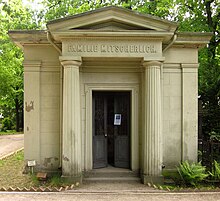Eilhard Mitscherlich
Eilhard Mitscherlich | |
|---|---|
| Awards | Pour le Mérite for Sciences and Arts (1842) Royal Medal (1829) ForMemRS (1828) |
| Scientific career | |
| Fields | Chemist |
| Institutions | University of Berlin |
| Doctoral advisor | Friedrich Stromeyer |
| Doctoral students | Heinrich Gustav Magnus |
Eilhard Mitscherlich (German pronunciation: [ˈaɪ̯lhaʁt ˈmɪtʃɐlɪç];[1][2] 7 January 1794 – 28 August 1863) was a German chemist, who is perhaps best remembered today for his discovery of the phenomenon of crystallographic isomorphism in 1819.
Early life and work
Mitscherlich was born at Neuende (now a part of
The abdication of
In 1818 Mitscherlich went to
Isomorphism

In the course of investigating the slight differences discovered by
Later work and last years
In 1833 Mitscherlich made a series of careful determinations of the vapor densities of a large number of volatile substances, confirming the law of
Mitscherlich was an honorary member of almost all the great scientific societies, and received the gold medal from the

In December 1861, symptoms of
Papers
Mitscherlich published, according to the "Catalogue of Scientific Papers", some 76 papers, which appeared chiefly in the "Abhandlungen der Königlichen Akademie der Wissenschaften in Berlin", in
Notes
- ISBN 978-3-411-04067-4.
- ISBN 978-3-11-018202-6.
- ^ a b c d Chisholm 1911, p. 627.
- ^ Mitscherlich, E. (1819): Ueber die Kristallisation der Salze in denen das Metall der Basis mit zwei Proportionen Sauerstoff verbunden ist. Abhandlungen der Akademie der Wissenschaften zu Berlin, Jg.1818–1819, pp.427–437. [1]
- .
- ^ (Anonymous) (1864). "Eilhard Mitscherlich (Obituary)". Proceedings of the Royal Society of London. 13: ix–xvi.
- ^ Chisholm 1911, pp. 627–628.
- ^ E. Mitscherlich (1834) "Ueber die Aetherbildung" (On the formation of ether), Annalen der Physik und Chemie, 31 (18) : 273–282.
- ^ J. J. Berzelius, Årsberättelsen om framsteg i fysik och kemi [Annual report on progress in physics and chemistry], (Stockholm, Sweden: Royal Swedish Academy of Sciences, 1835). After reviewing Eilhard Mitscherlich's research on the formation of ether, Berzelius coined the word katalys (catalysis) on page 245:
Original: Jag skall derföre, för att begagna en i kemien välkänd härledning, kalla den kroppars katalytiska kraft, sönderdelning genom denna kraft katalys, likasom vi med ordet analys beteckna åtskiljandet af kroppars beståndsdelar medelst den vanliga kemiska frändskapen.
Translation: I shall, therefore, to employ a well-known derivation in chemistry, call [the catalytic] bodies [i.e., substances] the catalytic force and the decomposition of [other] bodies by this force catalysis, just as we signify by the word analysis the separation of the constituents of bodies by the usual chemical affinities.
- ^ a b c Chisholm 1911, p. 628.
- ^ Rose, G. (1864): Zur Erinnerung an E. Mitscherlich. Zeitschrift der Deutschen Geologischen Gesellschaft, vol. 16, pp. 21–72. [2]
- ^ Mitscherlich, E. (1833): Ueber das Benzin und die Säuren der Oel- und Talgarten. Annalen der Physik (Poggendorff), vol. 105 (=Ser. 2, vol. 29), pp. 231–237. [3]
- ^ The American Cyclopædia.
- ^ New International Encyclopedia(1st ed.). New York: Dodd, Mead.
- ^ "Book of Members, 1780–2010: Chapter M" (PDF). American Academy of Arts and Sciences. Retrieved 15 September 2016.
- ^ Mitscherlich, E.: Lehrbuch der Chemie. Ernst Siegfried Mittler, Berlin. Band 1, Abth.1 (1829) = 194 p.; Band 1, Abth.2 (1832) = 532 p.; Band 2, Abth.1 (1835) = 216 p.; Band 2, Abth.2 (1840) = 500 p.
Further reading
- Eilhard Mitscherlich: Prince of Prussian Chemistry by Hans-Werner Scuhtt, 1997, ISBN 0-8412-3345-4
- Obituary of Eilhard Mitscherlich in Proceedings of the Royal Society of London, volume XIII, 1864 (pages ix – xvi, near the end of the volume)
See also
References
- This article incorporates text from a publication now in the public domain: Chisholm, Hugh, ed. (1911). "Mitscherlich, Eilhardt". Encyclopædia Britannica. Vol. 18 (11th ed.). Cambridge University Press. pp. 627–628.
- Eilhard Mitscherlich at the Mathematics Genealogy Project
